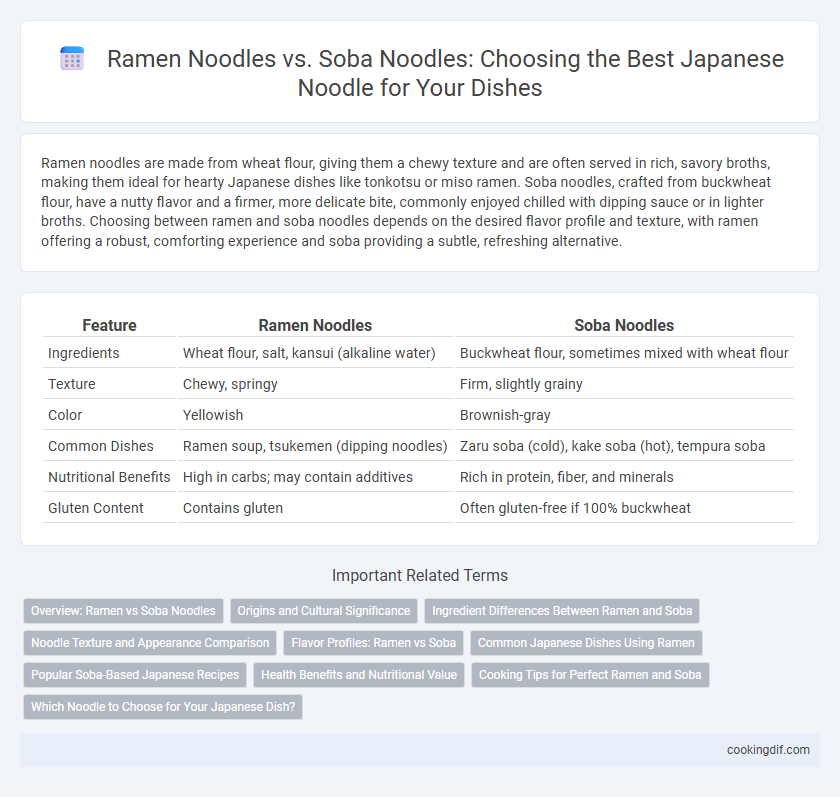Ramen noodles are made from wheat flour, giving them a chewy texture and are often served in rich, savory broths, making them ideal for hearty Japanese dishes like tonkotsu or miso ramen. Soba noodles, crafted from buckwheat flour, have a nutty flavor and a firmer, more delicate bite, commonly enjoyed chilled with dipping sauce or in lighter broths. Choosing between ramen and soba noodles depends on the desired flavor profile and texture, with ramen offering a robust, comforting experience and soba providing a subtle, refreshing alternative.
Table of Comparison
| Feature | Ramen Noodles | Soba Noodles |
|---|---|---|
| Ingredients | Wheat flour, salt, kansui (alkaline water) | Buckwheat flour, sometimes mixed with wheat flour |
| Texture | Chewy, springy | Firm, slightly grainy |
| Color | Yellowish | Brownish-gray |
| Common Dishes | Ramen soup, tsukemen (dipping noodles) | Zaru soba (cold), kake soba (hot), tempura soba |
| Nutritional Benefits | High in carbs; may contain additives | Rich in protein, fiber, and minerals |
| Gluten Content | Contains gluten | Often gluten-free if 100% buckwheat |
Overview: Ramen vs Soba Noodles
Ramen noodles, typically made from wheat flour, water, salt, and kansui, have a chewy texture and a yellowish hue, making them ideal for brothy, rich dishes like tonkotsu and miso ramen. Soba noodles are crafted from buckwheat flour, which gives them a nutty flavor and a slightly grainy texture, commonly served cold with dipping sauce or in hot soups like kake soba. Both noodles differ significantly in ingredients, texture, and traditional pairings, impacting their use in Japanese cuisine and flavor profiles.
Origins and Cultural Significance
Ramen noodles, originating from Chinese-style wheat noodles introduced to Japan in the early 20th century, have become a staple in Japanese cuisine with regional variations like Sapporo and Hakata styles reflecting local flavors. Soba noodles, made from buckwheat, trace back to the Edo period and hold cultural significance in rituals such as toshikoshi soba eaten on New Year's Eve to symbolize longevity and resilience. Both noodle types embody distinct historical roots and cultural traditions, shaping their unique roles in Japan's culinary heritage.
Ingredient Differences Between Ramen and Soba
Ramen noodles are made primarily from wheat flour, water, salt, and kansui, an alkaline mineral water that gives them a firm texture and yellowish hue. Soba noodles are crafted from buckwheat flour, often blended with wheat flour, resulting in a nutty flavor and a darker, grayish-brown color. The distinct ingredients influence their texture, taste, and traditional usage in Japanese cuisine.
Noodle Texture and Appearance Comparison
Ramen noodles feature a springy, chewy texture with a smooth, yellowish appearance due to the use of alkaline kansui water. Soba noodles possess a firmer, slightly grainy texture with a matte, light brown to grayish color, attributed to buckwheat flour. The contrast in texture and color between ramen and soba noodles significantly influences their pairing with broths and presentation in Japanese dishes.
Flavor Profiles: Ramen vs Soba
Ramen noodles boast a rich, savory flavor with a chewy texture, often infused with pork or soy-based broths that create a hearty and umami-packed experience. Soba noodles offer a subtle, nutty taste derived from buckwheat flour, providing a lighter and earthier profile that pairs well with delicate dashi broths or chilled dipping sauces. The contrasting flavor profiles highlight ramen's robust intensity versus soba's refined simplicity, shaping their respective roles in authentic Japanese cuisine.
Common Japanese Dishes Using Ramen
Ramen noodles, made from wheat flour, water, and kansui alkaline water, are essential in popular Japanese dishes like Shoyu Ramen, Miso Ramen, and Tonkotsu Ramen, where their chewy texture absorbs rich broths effectively. In contrast, soba noodles, crafted from buckwheat flour, offer a nuttier flavor and are commonly used in dishes such as Zaru Soba and Tempura Soba, highlighting their versatility in cold and hot preparations. The choice of noodle significantly influences the dish's taste profile, with ramen favored in hearty, broth-based meals and soba preferred for lighter, refreshing servings.
Popular Soba-Based Japanese Recipes
Soba noodles, made from buckwheat flour, offer a nutty flavor and chewy texture distinct from the wheat-based ramen noodles commonly used in Japanese cuisine. Popular soba-based Japanese recipes include Zaru Soba, a cold noodle dish served with dipping sauce, and Kake Soba, a hot noodle soup often garnished with green onions and tempura. Soba noodles are valued for their versatility and health benefits, making them a staple in traditional and modern Japanese meals.
Health Benefits and Nutritional Value
Ramen noodles, typically made from wheat flour, offer a higher carbohydrate content but can be lower in fiber compared to soba noodles, which are primarily made from buckwheat and provide more protein and essential minerals like manganese. Soba noodles are rich in antioxidants and have a lower glycemic index, promoting better blood sugar control and heart health. Choosing soba noodles can enhance the nutritional profile of Japanese dishes by adding vitamins, fiber, and balanced amino acids absent in traditional ramen.
Cooking Tips for Perfect Ramen and Soba
Ramen noodles require boiling in rapidly boiling water for 2-3 minutes to achieve a chewy texture, then rinsing with cold water to stop cooking and remove excess starch. Soba noodles demand careful timing, typically cooking for 4-5 minutes, followed by immediate rinsing under cold water to maintain their firm, nutty flavor and prevent mushiness. Using a large pot with ample water ensures even cooking for both ramen and soba, while stirring gently prevents noodles from sticking together.
Which Noodle to Choose for Your Japanese Dish?
Ramen noodles, made from wheat flour, water, salt, and kansui, offer a chewy texture and are ideal for rich, savory broths like tonkotsu or miso. Soba noodles, crafted from buckwheat flour, provide a nutty flavor and a firmer bite, making them perfect for lighter dishes such as zaru soba or cold noodle salads. Choosing between ramen and soba depends on the desired dish complexity and broth richness in your Japanese culinary creation.
Ramen noodles vs soba noodles for Japanese dishes Infographic

 cookingdif.com
cookingdif.com